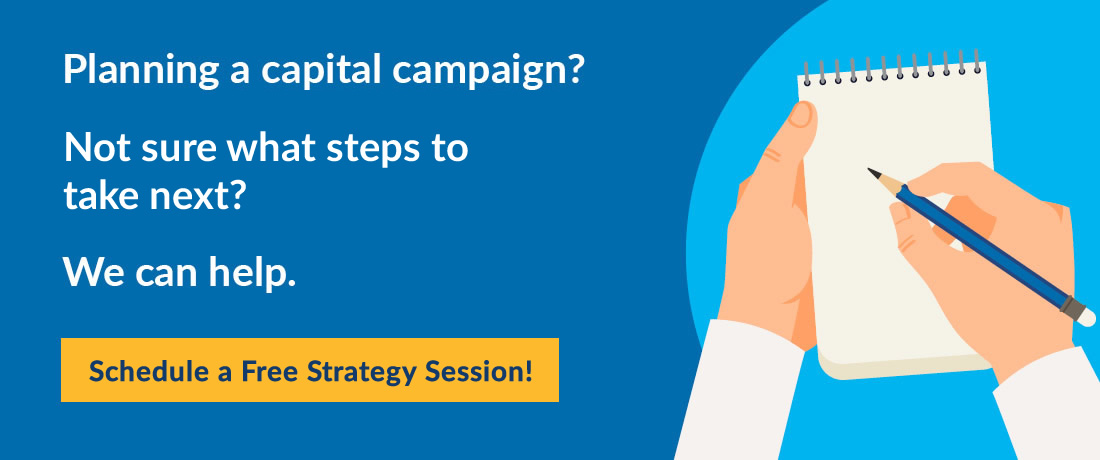Not Ready for Your Capital Campaign? Don’t Pause – Dive In!

It’s a rare organization that finishes a feasibility study and learns that they have all the lead prospects they need to have a hugely successful campaign.
Far more likely, you’ll have found that only a few of those prospects who know your organization are excited about your campaign plans and are ready to step up and make a top tier gift.
In fact, if you can identify all those top donors right off the bat, perhaps you’re not shooting high enough.
To Pause or Not to Pause (Your Campaign)…
Answer this important question:
If you’ve just finished your feasibility study and it didn’t turn up those top tier donors who have indicated their willingness to make a lead gift, should you put your campaign plans on hold while you get ready?
…or…
Should you use your campaign planning to motivate the work that needs to be done?
Over my decades in the capital campaign business, I have read a lot of feasibility study reports. My heart always sinks when the report says that the organization isn’t ready for a campaign. I can feel the momentum and energy disperse as I read those recommendations.
Common (but not necessarily good) reasons to pause a campaign
Those discouraging feasibility study reports often point to three common situations:
- The organization isn’t well-known in the community.
- The development office isn’t ready.
- The study didn’t identify enough donors who indicated they would give at levels needed to reach the campaign goal.
The report is presented to the board and, discouraged, the board puts the campaign on hold, charging the staff to rectify the failings. Momentum is lost and the campaign plans are paused for an indefinite period.
Consider this approach instead — Dive In!
Rather than pausing the campaign and waiting while the staff finds a way to correct the problems, you can use the campaign to motivate and fund the work that’s got to be done.
What if — instead of being derailed by believing that you aren’t ready for a campaign — you double down on your campaign. If your campaign is important and will have a big impact on the people you serve, you can use it to create the pressure needed to get your organization ready.
That process may take 3 months or 6 months or even a year, but with specific readiness objectives, a clear plan, and funding for the staff necessary to carry it out, you can focus on what needs to be done in the context of the campaign.
3 Reasons You Might (But Shouldn’t) Pause a Campaign
Consider the three common situations listed above that pause campaigns.
1. Your organization’s not well-known in your community.
This reason to pause a campaign always flummoxes me. For most organizations, it doesn’t matter if the person on the street knows about your organization. What matters is that the funders in your community (foundations, lead donors and perhaps business donors) know about your organization and why what you do matters to them.
In many communities — even good-sized cities — that’s a mere handful of people (perhaps 20 or 30 of them). And it doesn’t take a big public relations campaign to get those people to know and believe in your organization. But it does take a plan and people on staff who have the time and ability to move that work forward.
You’ve got to be committed to doing that work. Knowing that you are in the planning mode for a campaign helps keep that commitment alive.
2. The development office isn’t ready.
Honestly, this one makes me laugh. While it’s ideal to have a well-organized development department that is fully staffed and with wonderful systems and excellent prospect research, I’ve rarely worked on a campaign where that was the case — at least, at the start of the campaign.
Through the campaign, using some money from the campaign budget, organizations can improve the staffing and function of their development offices. And they should. But it makes little sense to pause a campaign until that work is done.
In fact, I’ve worked on many successful campaigns with small development departments that have done wonders in managing the campaign.
- They might add some administrative staff to free up higher level people to be more efficient.
- They might contract with a writer and a prospect researcher to flesh out their abilities.
But those functions can be added in the context of the campaign.
3. The study didn’t identify enough donors who indicated they would give at the levels needed to reach the campaign goal.
This point speaks directly to what your campaign goal should be. And, if your feasibility study didn’t find solid indications that a few of the large gifts needed will be there, then you may have to reduce your goal.
However, with a dedicated and strategic effort to actively engage lead gift prospects in your campaign planning, you might well be able to build new relationships with lead donors and inspire some lead donors to participate and give at levels they hadn’t considered before.
While some donor relationships are built over many years, others are created more quickly. And the campaign process itself provides many opportunities to involve prospective donors in the planning process which is one of the very best ways to draw donors close.
Don’t Pause Your Campaign; Double Down Instead
It may be tempting to pause. Campaigns are scary and require energy and commitment and time. But don’t give into the allure of stepping back. You’ll lose the momentum you’ve created and your campaign will fall into a limbo state that often lasts a long time.
Instead of pausing your campaign while you get your ducks in a row, double down on the campaign process. Create a plan with specific objectives and timetables. Use the pre-campaign processes to provide motivation, a budget and pressure to do what needs to be done to make your campaign successful.
Don’t be lured into thinking that you’ll be better off stepping back to get ready before you move into a campaign. Instead, think of all of that readiness work as the first stage of your campaign.




Spot on, Andrea! Your post speaks to where we are currently… in the first “Preliminary” stage of a much-needed campaign. Thank you for bravely offering words that speak to me in this moment!
I’m so glad it speaks to you. It’s so tempting to pull back and use the fact that you aren’t fully ready as an excuse to do so. Campaigns are scary and some times you’ve just got to take a deep breath and just keep going — right through the discomfort and anxiety. Good for you, Kathryn.
Just what I needed to hear today to remind me to keep plugging away in the early stages to build momentum!